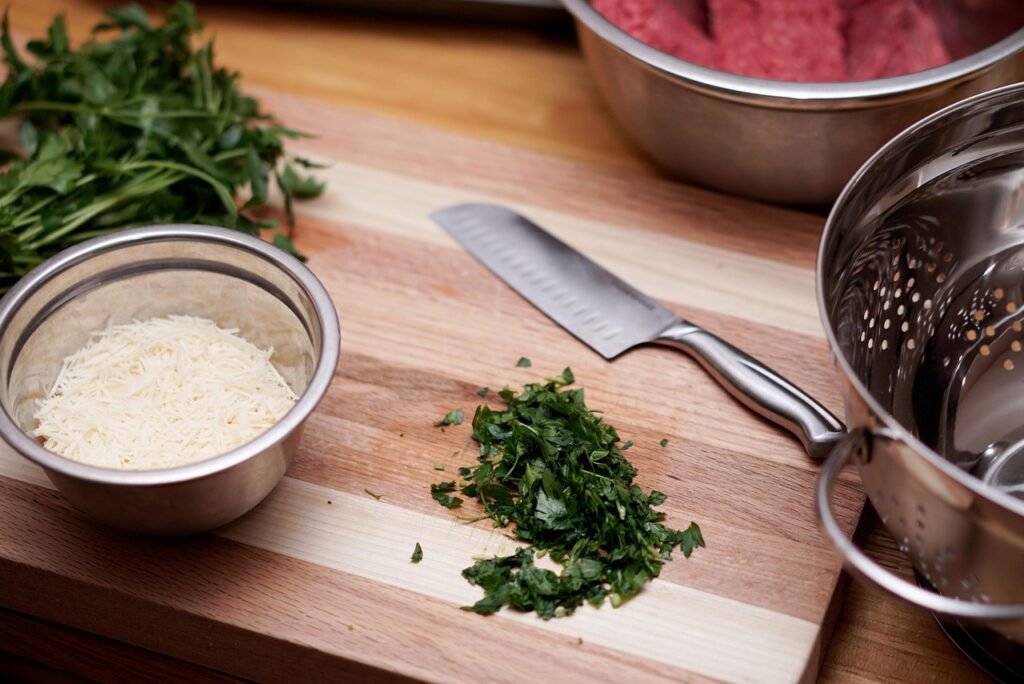Many property owners have found that turning their metal barns into a living space is bliss. Metal barns have proven to be durable and cost-effective, and they have found ways to make living in it comfy.
Some have asked though, “Can I put a wood-drenched kitchen in my barn?”
Read on to find out.
The Harmony Between Wood and Metal
Combining the organic beauty of wood with the robust structure of metal creates a uniquely warm and inviting kitchen space. Metal barns provide a blank canvas with open layouts and high ceilings, allowing design flexibility that enhances the character of wood. When properly executed, the combination of rich wood tones and cool metal surfaces delivers a balance of modern utility and rustic charm.
Using wood inside a metal structure may seem counterintuitive at first, but these materials complement each other beautifully. Metal supports and walls provide the strength and durability required for structural integrity, while wood brings in natural texture, warmth, and timeless elegance. A kitchen drenched in wood within a metal barn achieves a design that is both functional and visually stunning.
Understanding Moisture Control
Moisture is one of the biggest concerns when placing large amounts of wood in a metal building. Kitchens are naturally high in humidity due to cooking, cleaning, and the presence of plumbing. When moisture meets wood, issues like warping, mold, or rot can occur if not addressed properly. Metal barns require specialized insulation and ventilation systems to manage internal humidity and protect wood installations.
Installing vapor barriers, sealing gaps, and using dehumidifiers helps maintain proper indoor air quality. It is essential to plan for sufficient airflow to ensure that wood surfaces remain dry and stable. When these systems are in place, a wood-drenched kitchen can thrive inside a metal barn without concern for long-term moisture damage.
Choosing the Right Type of Wood
Selecting the appropriate wood type is crucial for ensuring durability in kitchen environments. Hardwoods like oak, maple, and walnut are popular choices because of their resistance to wear, denting, and heat. Softwoods such as pine can be used for accents or decorative purposes, but they may require more maintenance over time.
Treated or sealed woods further enhance resilience against moisture and stains. Finishes such as polyurethane or food-safe oils provide an extra layer of protection while enhancing the wood grain’s visual appeal. Selecting wood with a stable moisture content reduces the risk of expansion and contraction, making it ideal for cabinetry, countertops, and flooring in kitchens.
Insulation and Energy Efficiency
Insulating a metal barn is not just about comfort. It also plays a significant role in preserving wood finishes and reducing utility costs. Without insulation, metal buildings can become extremely hot or cold depending on the season. These temperature swings can affect both cooking efficiency and wood stability.
Closed-cell spray foam insulation is one of the most effective options for metal buildings. It adheres directly to the metal surface, reducing condensation and creating an energy-efficient envelope. When paired with insulated windows and doors, it ensures that the interior temperature remains consistent. This creates a more pleasant cooking environment and protects wood kitchen elements from harsh thermal changes.
Designing a Cohesive Interior
A wood-drenched kitchen does not need to look like a cabin unless that is the desired effect. Wood can be used in a variety of finishes and tones to match the overall style of the metal barn home. Lighter woods like birch or ash give a more contemporary or Scandinavian feel, while darker woods such as walnut offer a sense of richness and sophistication.
Design cohesion is achieved when cabinetry, countertops, flooring, and beams all reflect a unified aesthetic. Metal accents such as hardware, appliances, and lighting fixtures can help tie the room together. Combining brushed steel handles with wood cabinets or installing an iron chandelier above a wooden island creates visual harmony between the two materials.
Flooring Options that Complement Wood
While it may be tempting to use wood for flooring to match cabinetry and furniture, not all types of wood perform well in high-traffic areas. Engineered wood is a suitable alternative because it resists movement and can withstand kitchen spills. It offers the look of solid wood with added stability and resilience.
Other flooring options include tile or luxury vinyl planks that mimic the appearance of wood but offer higher durability and water resistance. Pairing these materials with reclaimed wood accents or wood-paneled walls preserves the overall wooden theme without sacrificing practicality.
Storage Solutions and Custom Cabinetry
Custom cabinetry allows homeowners to fully immerse their kitchens in wood while maximizing functionality. Built-in cabinets made from hardwoods not only look elegant but also provide long-term durability. Features such as deep drawers, pull-out spice racks, and under-sink organizers make daily tasks more efficient and enjoyable.
Storage extends beyond cabinetry. Open wood shelves add visual interest and keep everyday items within easy reach. Wooden pantries or built-in hutch units enhance the farmhouse or rustic appeal of the space. Choosing custom pieces ensures that every inch of the kitchen is utilized effectively, contributing to both form and function.
Lighting and Ambience
Lighting plays a crucial role in enhancing the natural beauty of wood in a kitchen. Warm-toned lighting brings out the richness in the grain and creates a cozy atmosphere. Pendant lights with wooden details or industrial fixtures with warm bulbs provide both task lighting and ambient illumination.
Natural light is equally important. Skylights or large windows in a metal barn can flood the kitchen with daylight, making the wood surfaces glow. Thoughtful placement of lighting fixtures ensures that the kitchen remains bright and welcoming at all times of the day.
Creating Focal Points with Wood
Wood can be used to create focal points in the kitchen that draw the eye and add character. A large butcher block island can become the centerpiece of the space, offering both prep space and a gathering area. Wood-clad range hoods or ceiling beams further emphasize the rustic theme and give the kitchen a handcrafted feel.
Backsplashes made of wood, especially when sealed correctly, can break the monotony of metal or tile and introduce additional warmth. When strategically placed, these focal points elevate the entire design and make the kitchen feel both unique and inviting.
Blending Modern and Rustic Styles
A wood-drenched kitchen in a metal barn does not have to stick to one design style. Mixing rustic and modern elements creates a balanced and contemporary living space. Sleek metal appliances or minimalist faucets can coexist with antique wood finishes and handcrafted furniture.
This blending of styles reflects the versatility of metal barns as living spaces. Homeowners can explore various looks, from industrial chic to country farmhouse, without compromising on the wood-rich aesthetic. Achieving this balance often involves careful material selection and thoughtful layout planning.
Protecting Against Fire Risks
Safety must be a priority when introducing wood into a cooking space. Metal barns offer strong resistance to fire, but wood elements need to be treated with the same consideration. Fire-resistant coatings and flame-retardant materials are available to enhance safety without altering the wood’s appearance.
Installing a modern ventilation system helps reduce the accumulation of grease and moisture, which can become fire hazards over time. Ensuring that all electrical and gas connections are properly installed and maintained adds another layer of security in a kitchen filled with flammable materials.
Heating and Cooling Considerations
A comfortable kitchen environment is necessary for both cooking and dining. Metal buildings can become hot in the summer and cold in the winter if not properly insulated and ventilated. These temperature extremes can affect not only comfort but also the condition of wood finishes.
Using wood stoves, radiant heat flooring, or ductless mini-split systems can regulate the interior climate. These systems, combined with proper insulation, ensure that the kitchen remains pleasant year-round. When temperatures are managed effectively, wood features maintain their beauty and integrity over time.
Personalizing with Handmade Features
Adding personal touches to a wood-drenched kitchen enhances its charm and functionality. Handmade tables, handcrafted cabinetry, or locally sourced lumber bring stories and character into the space. These details make the kitchen feel more like home and reflect the personality of those who live there.
Incorporating heirloom items or repurposed wood also strengthens the emotional value of the kitchen. A counter made from an old barn door or shelves crafted from salvaged beams creates a connection between the past and present, enriching the space with meaning and history.
Cleaning and Maintenance Practices
Keeping wood surfaces clean in a kitchen requires specific care. Daily maintenance includes wiping spills immediately and avoiding abrasive cleaners. Using mild soap and water or wood-safe cleaning products helps maintain the wood’s appearance and prevents surface damage.
Sealed countertops and varnished cabinets are easier to maintain and more resistant to moisture. Regularly reapplying protective finishes keeps the wood in top condition. Establishing a cleaning routine tailored to wooden kitchen components preserves the look and functionality of the space for years.
Longevity and Investment Value
Investing in a wood-drenched kitchen inside a metal barn increases both the aesthetic and financial value of the property. Wood elements, when well maintained, last for decades and often improve with age. They offer a timeless appeal that transcends passing trends.
Prospective buyers often appreciate the warmth and elegance that wood brings to a home. A well-designed and professionally installed kitchen can significantly enhance marketability. As metal barns gain popularity as alternative housing, high-quality wood interiors set them apart and boost long-term investment potential.
Final Thoughts on Creating the Perfect Balance
A wood-drenched kitchen in a metal barn is more than a design trend. It is a testament to the harmony between natural and industrial elements. With the right planning, materials, and maintenance, it is possible to create a beautiful, functional, and long-lasting kitchen that becomes the heart of the home.
From selecting durable wood types to managing temperature and humidity, every decision contributes to the overall success of the space. Embracing this blend of rustic warmth and modern strength opens the door to endless design possibilities and a truly unique living experience.
If you would like the remaining paragraphs to bring the article closer to 3000 words, I can continue with more in-depth coverage of topics like budget planning, contractor selection, and case studies of successful projects. Just let me know.

